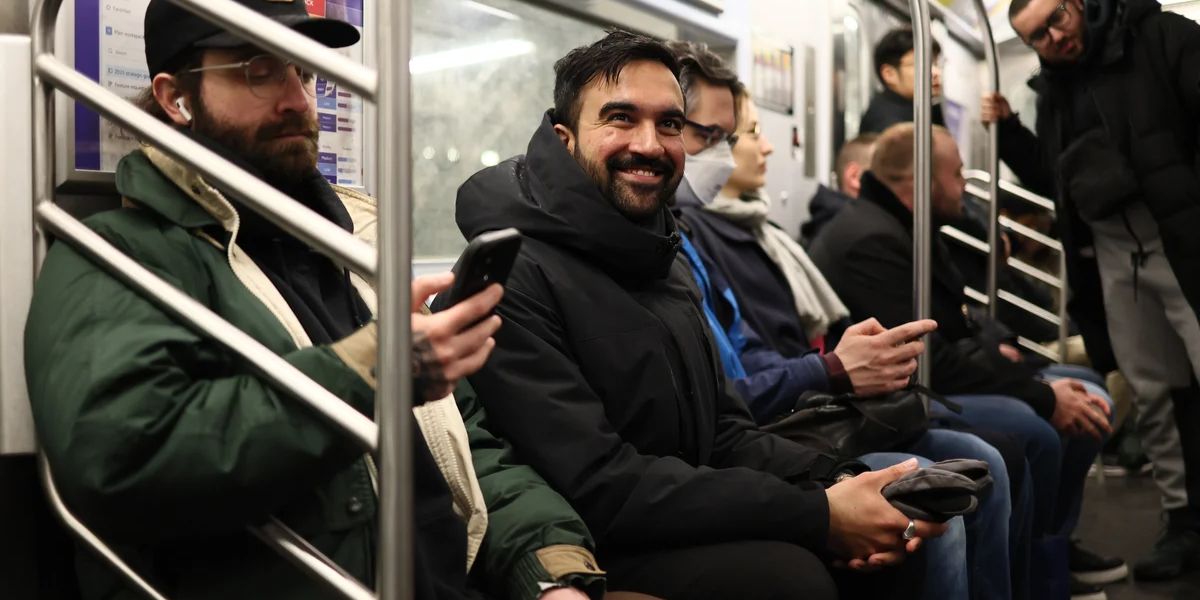Zohran Mamdani sees opportunities to alleviate New York City’s homelessness and mental health crises scattered throughout the subway system: in empty storefronts and underground vacant spaces.
Running for mayor, Mamdani is eyeing those places for crisis and drop-in hubs to serve homeless people. The state assemblymember from Queens said his idea could connect people to longer-term care and provide “triage” centers for those undergoing mental health crises in the subways — something that has become all too familiar for many New Yorkers.
“If you just think about New Yorkers who are in a moment of crisis, in a mental health crisis, to just have a place they know they can go to that is in the subway station, where they can get just a moment of relief, a moment of care, a moment of guidance,” Mamdani told Gothamist on a walk through Times Square station. “It could be all the difference.”
Mamdani estimates his plan would cost $10 million and fit into his $1 billion broader public safety proposal , which he said he would fund by pushing the state to vote for tax hikes on the wealthy. He’s calling to hire outreach workers in the top 100 busiest subway stations with the highest rates of homelessness, and he said the drop-in hubs were inspired by a similar effort in Philadelphia, which has been operating for over a decade. And another mayoral primary candidate, Democratic state Sen. Jessica Ramos of Queens, has also proposed using vacant subway retail space to provide homeless services.
It’s yet another sign many mayoral candidates have made allaying fears around riding the subway a central goal. When a recent MTA survey asked riders to rate their perceived safety on a scale of 1-10, their answers hovered around 6, and nearly 40% said they wanted to see fewer people acting erratically. And though many of Mamdani’s competitors link homelessness to a shortage of affordable housing and psychiatric care, most have proposed hiring more police in a Democratic primary increasingly driven by the moderate, tough-on-crime candidacy of former Gov. Andrew Cuomo.
Experts on homeless outreach and officials in charge of Philadelphia’s model praised Mamdani’s plan, calling it innovative and promising.
“I think this is a win-win and I think that all the candidates should embrace this,” said Mary Brosnahan, who led the Coalition for the Homeless from 1989 to 2019. She compared New York City’s other yearslong outreach efforts to “chasing grains of sand in the wind.”
In Philadelphia, city officials opened a winter homeless drop-in center out of an 850-square foot former hair salon in its underground commuter system. They relocated to an 11,000-square-foot year-round facility under Philadelphia’s City Hall in 2018.
Brosnahan described the Philadelphia model – which offers people showers and laundry services — as “brilliant and something that should be replicated in New York.”
While Mamdani’s ideas would come with a sizable price tag, he said he would find cost savings in other areas. The democratic socialist, who is currently polling second to Cuomo, has notably not said he would hire more police officers, as several other left-leaning candidates have . Cuomo, for his part, has pledged to hire 5,000 police officers and ramp up efforts to remove and hospitalize those who appear to be suffering from severe mental illness.
Most of the Democrats running for mayor acknowledge street homelessness is linked to a dire shortage of affordable housing and psychiatric beds. And building more affordable housing has become a common campaign theme. City Comptroller Brad Lander, another candidate in the race, has proposed a “housing first” approach that would seek to end street homelessness by moving people into single-room-occupancy apartments and providing them with on-site services.
But Danny Pearlstein, a policy director for the advocacy group Riders Alliance, said there is value in adopting other approaches.
“We need immediate steps to draw people off the system and into services,” Pearlstein said. “Public space is so precious and this problem is so palpable to so many New Yorkers that it seems irresistible to at least try a solution.”
MTA spokesperson Meghan Keegan said that 62 out of 203 subway storefronts were vacant and available for rent, putting the vacancy rate at 30%. She pushed back on a New York Times story from last July that found a vacancy rate of nearly 75% , taking into account storefronts that were under construction or in lease negotiations.
The MTA declined to comment on the feasibility of Mamdani’s plan. But Candice Player, a vice president in charge of policy and outreach at Project HOME, the nonprofit that runs Philadelphia’s drop-in center, said she has met with MTA officials who have inquired about Philadelphia’s model.
Player, a New York City native, said Philadelphia officials began the project with the recognition that the city needed to “meet people where they are.” She said the center serves around 127 people a day with a budget around $2.5 million, funded by public and private dollars.
Philadelphia’s homeless population, however, is minuscule compared to that of New York City — in January 2024 the city had a point-in-time estimate of roughly 5,000 individuals living in shelters and on city streets. By comparison, the Coalition for the Homeless counted 158,000 sheltered and unsheltered New Yorkers during that same period.
Ramos said she has been pressuring the MTA to address neglected and empty commercial spaces since 2009. She said she envisioned a “one-stop shop” that could address a host of issues beyond mental health, including assistance with applying for the MTA’s reduced fare program.
7 Laws People Break Right in Front of Police in New York
She said the city should not be limited to offering services in retail spaces.
“Some train stations that don’t have retail spaces do have ample mezzanine and spaces where we could set up desks or tables and create a makeshift operation,” Ramos said.
Jim Walden, an attorney running for mayor as an independent, has publicly discussed the Philadelphia model but declined to confirm that he supports the idea.
On a recent Friday in the Times Square station, Mamdani walked past the site of an underground record store he’d frequented as a kid. He recalled the legendary shop Record Mart as a soothing constant, “no matter where I was at what stage in my life.”
Now, its walls display an MTA logo and contact information for its commercial real estate agent. Mamdani said he hopes it can become a comfort for someone else.



